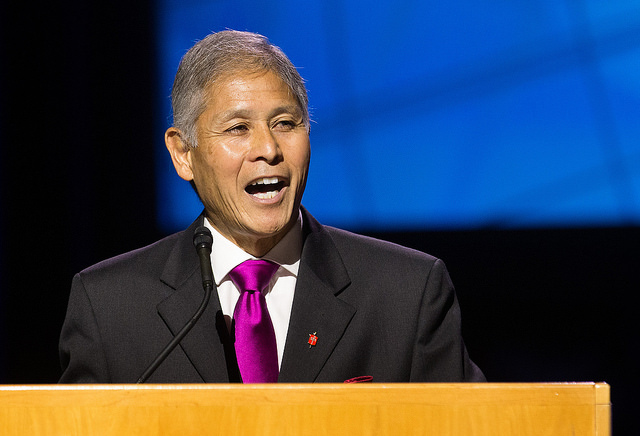General Conference hears about the achievements, vision and goals of The UMC’s Four Areas of Focus.
MARY ANDREOLLI
General Bd of Global Ministries
On May 16 the General Conference received a 15-minute presentation on the achievements, vision, and work that is part of The United Methodist Church’s Four Areas of Focus. The four focus areas — engaging in ministry with the poor; improving health globally; developing principled Christian leaders; and creating new places for new people — were first affirmed at the 2008 General Conference.
Undergirding the Four Areas of Focus presentation was a resounding emphasis on sharing the gospel of Jesus Christ in every place by following the Wesleyan tenets of taking the church to the people, creating a culture of disciple-making, and taking ministry to people who need it most and often. According to Emily Innes, lay representative of the Southeast Jurisdiction for the Connectional Table, “Disciple-making isn’t something you graduate and retire from… it’s who we are, not what we do.”

Achievements of the last four years named by the diverse group of lay and clergy presenters included the creation of more than 2,000 faith communities, the training of thousands of laity for ministry with the poor, and the establishment of 1,000 health workers around the world to eliminate preventable diseases of poverty.
The vision for the Four Areas of Focus for the next quadrennium is:
- Developing principled Christian leaders: Engage 3 million plus people in world-transforming activities
- Creating new places for new people and revitalizing existing congregations: Form 1 million new disciples of Jesus Christ
- Improving health globally: Reach 1 million children with lifesaving interventions and engage 10,000 churches in the United States in developing support systems for treatment, education, and prevention in their surrounding communities
- Engaging in ministry with the poor: Transform 400 communities for vital, abundant living
In addition, there is a direct connection between the four focus areas and a church’s vitality. The more churches participate in the four focus areas, the more likely they are to become vital congregations. The goal for vital congregations is to double the number of highly vital congregations in the next four years.
A press conference was held after the presentation with agency leaders and bishops: Susan Henry-Crowe, general secretary, General Board of Church and Society; Thomas Kemper, general secretary, General Board of Global Ministries; Bishop Grant Hagiya, (Greater Northwest Area); Bishop John Michael Lowry (Fort Worth Area); and Bishop John R. Schol (New Jersey Area).
Each presenter shared unique and overlapping perspectives on the Four Areas of Focus. Below are the highlights:
As part of the developing principled Christian leaders focus area, Bishop Hagiya introduced a new campaign called, “God is calling you out.” This evocative statement is designed to instill in young people a sense that the gospel of Jesus Christ compels them to make a difference in the world. Hagiya sees social media as being the key to connecting to young people.
When asked what the starting point is for the new four focus areas goals, Susan Henry- Crowe responded:
“Ministry with the Poor has already begun articulating a strategy that will cut across all the annual conferences around the world and inspire congregations and communities to get on board. In this next quadrennium, Ministry with the Poor will extend beyond soup kitchens so we can begin to eradicate poverty instead of sustaining poverty.”

When asked what the word “vital” means as it relates to vital congregations, Bishop Schol replied, “Vital congregations are measured by various markers in our statistical data. In addition, we see in vital congregations five key distinctions: 1. Worship that is attractive and inspiring; 2. Disciples engaged in small groups; 3. Mission in neighboring communities; 4. Generous giving to mission; and 5. Disciples making new disciples.”
The goal of vital congregations is to double the number of vital congregations in the next quadrennium from 14.7 percent to 29.4 percent.
When asked how the agencies will work together on fulfilling the Four Areas of Focus goals, Thomas Kemper, Global Ministries’ general secretary, replied:
“We heard this morning that 360,000 malaria nets were distributed in Sierra Leone. In some villages where the nets were distributed, the people asked for a pastor. We are not distributing nets to make Christians, we are distributing nets to keep people alive. But in this example, you can see how the Four Areas of Focus are easily interrelated. It is a myth that agencies don’t work well together. We are all in this together.”
Bishop Hagiya added, “Cooperation is not the problem, our delivery system is. The problem is how do young people connect to the church when they don’t know how to navigate the UMC infrastructure?”
Last Updated on December 15, 2023

